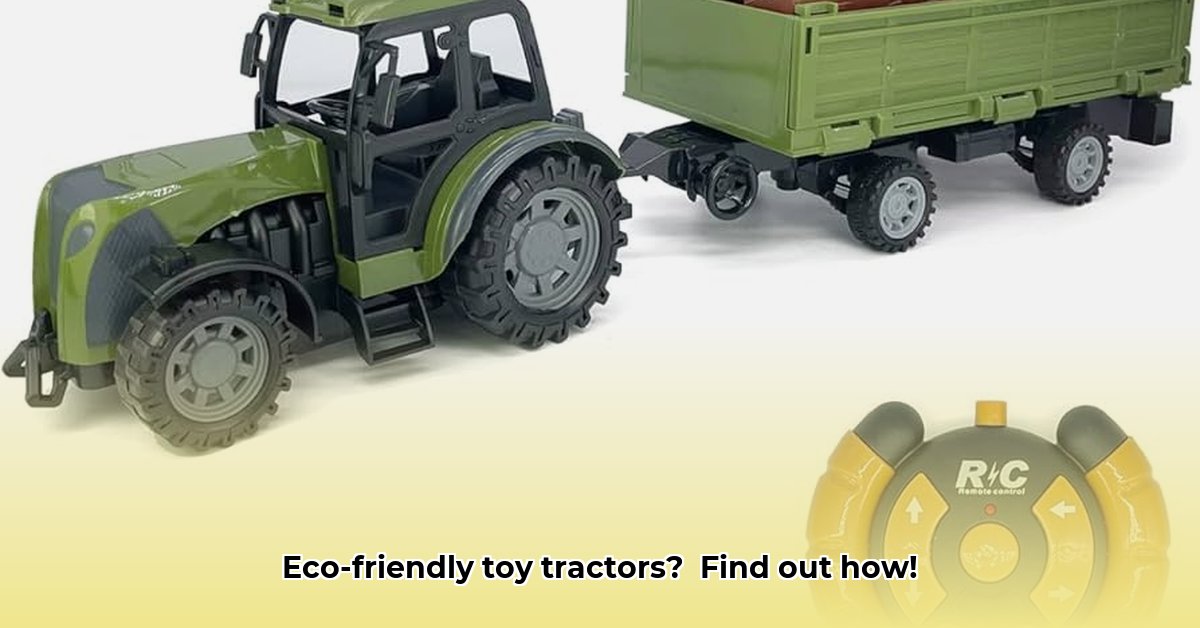
Remote Control Tractor and Trailer: Driving Towards a Greener Future
The toy aisle is changing. Parents are increasingly seeking eco-friendly options, and the world of remote control (RC) vehicles is starting to respond. While hundreds of RC tractors and trailers are readily available online 1, finding truly sustainable versions feels like searching for a needle in a haystack of plastic. This article explores the challenges and opportunities in creating greener RC toys, examining the current landscape, the obstacles faced by manufacturers, and the steps needed to cultivate a truly sustainable future for this popular segment of the toy market. For more on eco-friendly RC tractors, check out this Ford Tractor Toy.
The Current State of Play: A Patchwork of Progress
The sheer volume of RC tractors and trailers available—easily found with a quick online search—highlights the market's size. However, a significant gap exists between the abundance of options and the availability of genuinely sustainable products. Many manufacturers emphasize carbon offsetting programs, yet these often fail to address the fundamental environmental impact of the toys' production. This begs the question: Why are truly sustainable RC tractors and trailers so rare?
The reality is complex. The use of sustainable materials often leads to higher production costs and manufacturing challenges. Adopting new, eco-friendly methods can disrupt established supply chains and cause delays in getting products to market. Moreover, consumer demand for sustainable toys isn't always reflected in a willingness to pay a premium price.
The Challenges of Eco-Friendly Farming (in Toy Form!)
The transition to sustainable manufacturing in the RC toy industry faces significant hurdles. Bioplastics, for instance, are considerably more expensive than conventional plastics. Switching to eco-friendly production methods requires substantial investment and can disrupt established supply chains. This makes it even more crucial for consumers to have clear, standardized information to compare the environmental impact of various products and avoid greenwashing, thus empowering informed choices.
A Fictional Tale of Success: "Green Fields Toys"
Imagine a company, "Green Fields Toys," dedicated to sustainable toy manufacturing. They use 100% recycled plastic and power their factory with renewable energy. Their journey wasn’t easy. They faced initial higher production costs and supply chain issues, but transparency and detailed information about their processes resonated with environmentally conscious consumers. Their business model showcases that sustainability isn't just a virtue; it can be a highly successful business strategy.
A Parent's Perspective: The Hunt for Sustainable Fun
Sarah, a mother of two, exemplifies the growing demand for sustainable toys. Her search for eco-friendly RC vehicles highlighted the lack of clear labeling and standardized sustainability metrics. She encountered vague and misleading claims, leaving her frustrated and unable to make informed purchasing decisions. Sarah's story underscores the urgent need for clear, consistent standards in labeling to facilitate consumer choices.
The Role of Governments and Regulations
Governmental intervention is crucial in driving change. Clearer regulations and standardized labeling are essential to empower consumer choices. Incentivizing sustainable practices through tax breaks or subsidies for manufacturers would accelerate the transition. Conversely, penalizing misleading environmental claims (greenwashing) would discourage deceptive marketing practices.
The Future of Sustainable RC Toys: A Collaborative Effort
The future of sustainable RC toys hinges on collaboration among manufacturers, consumers, and governments. Manufacturers must invest in research and development of eco-friendly materials and manufacturing processes. Consumers must demand transparency and support companies with verifiable sustainability claims. Finally, governments and NGOs must create a strong regulatory framework that incentivizes sustainable practices and penalizes misleading marketing tactics. This collaborative effort is essential to transforming the toy industry into a greener and more sustainable space.
Steps Towards a Greener Future: A Roadmap for Change
| Stakeholder | Short-Term Actions | Long-Term Goals |
|---|---|---|
| Manufacturers | Transparent sustainability reporting; explore bioplastics and recycled materials | Fully sustainable supply chains; circular economy models |
| Consumers | Support companies with verifiable eco-claims; reduce consumption | Demand transparency; choose durable, repairable toys |
| Regulators/NGOs | Develop and enforce clear eco-labeling standards | Incentivize green manufacturing; penalize greenwashing |
The journey toward sustainable RC toys is just beginning. But with commitment from all stakeholders, we can build a greener future for our children's play.